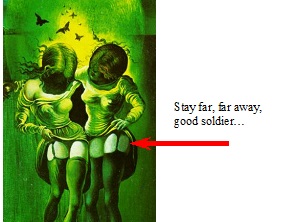I’m currently working on an article that revolves around theories of corporeality and the body, so I’ve been reading a range of feminist interpretations of the subject: Elizabeth Grosz‘s challenge to mind/body dualism by way of the Moebius strip paradigm; Susan Bordo and the body as a “cultural plastic”; and Iris Marion Young‘s articles on distinctly female body experiences, to name a few. As far as the body in literature and art, I have found numerous articles, books, and anthologies that delve into the complexities of the female body when represented by men vs. women in various mediums. For example, feminist critics have pointed out that, even though man does not “inhabit” the female body, he has nevertheless exerted control over its representation in cultural history. Even the most cursory investigation of canonical Western artists proves this statement true: Michaelangelo, Da Vinci, Rubens, Goya, Picasso…. Contemporary women artists must grapple with the subject-as-object paradox: “The meaning of the work relies on the paradox of woman as subject and object; viewers must at once be aware of the central figure as an object seen (of the dangerous and unpleasant objectification of woman) and as a subject who sees, a creative female agent, an artist” (Meskimmon 75).
In any case, combine this current project with the fact that my post on Salvador Dalí’s double images has been getting a lot of traffic lately and you have my newest Dalí-inspired piece: Nude Skulls and Double-Images… Spanish professor #clickbait?
Here is an example of what I’m referring to:

“In Voluptas Mors”(“Voluptuous/Desirable Death”) Women forming a human skull for Salvador Dali’s photo-shoot. Image via Metamythic: http://mag.metamythic.com/metamorphic-skull-illusions/
Dalí worked on this project with American photographer Philippe Halsman in 1951; the pair had collaborated on several other projects throughout the 1940s since their initial meeting in 1941. “In Voluptas Mors” (Voluptuous, or Desirable Death), the title given to this skull composed of seven nude women, apparently took over three hours to arrange. There are some fabulous articles and blog posts that discuss Dalí’s and Halsman’s “nude-skull” venture. Metamorphic Skull Illusions includes two of Dalí’s renditions of a skull made of human figures (the above photograph and a painting), as well as numerous other examples of sketches that contain double-image-skulls from different time periods all around the world. Dalí’s Skull Illusion Still Inspires details the way in which this particular visual has inspired tattoos, movie posters, magazine covers, and a variety of artistic endeavors. Finally, this site details the making of the image, including photographs like the one below that were taken from different angles as the models were positioned in their precise locations:
Since there seems to be a wealth of information regarding the creation of this specific image available online, I was curious as to whether Dalí produced other similar projects featuring the human form morphing into a skull. I knew he had done variations with portraits and “Disappearing busts…”, but a human skull creates a markedly distinct aura. Consulting one of my favorite books, Salvador Dalí. The Paintings, which contains nearly 1700 paintings, sketches, studies, and photographs of Dalí’s vast artistic output, I found several other examples of skulls created from the female form – granted, this time they aren’t “nudes”! Two paintings in particular caught my attention for their descriptors: “For the campaign against venereal disease” (the first is the “study” and the second is the final painting):
During his time in the U.S., Dalí’s work was often commissioned by different companies or organizations – I wrote about his unsuccessful Hallmark Christmas cards last year. These posters are another example. I wasn’t able to find much historically sound information regarding these images or who commissioned them online, and I’ll have to wait until the current semester ends to delve deeper into this history. I did, however, find a fascinating dissertation on Dalí’s decade-long stint in the United States during the 1940s that dedicates an entire chapter to the depiction of the human body in paintings such as these.
In her dissertation, A Spaniard in New York: Salvador Dalí and the Ruins of Modernity (1940-49), Gisela M. Carbonell-Coll argues that in Dalí’s 1940s paintings, “the partial body – its fragmentation and dismemberment – not only refers the viewer to the obvious consequences of the war but it is also used as a metaphor for its own decay as a result of venereal disease” (11). For Carbonell-Coll, the gender of these bodies is not their distinguishing characteristic – their status as incomplete, decaying and morphing bodies takes precedence (116). Thus, she omits feminine and masculine attributes when analyzing these images – noting that both male and female bodies appear fragmented and dismembered during this time – and opts instead to value them as “products of the socio-cultural output of the wartime years in America and the artist’s promotion as an artistic provocateur in this context” (117). The notion that the body (male and female) is “charged with political meaning” is significant (122), yet I disagree with the proposition that gender is of little significance in these paintings on venereal disease. If we consider the title of the study – “Soldier take warning” – as well as the juxtaposition of clearly male and female subjects, the work in fact communicates important anxieties regarding sexuality in the inter- and post-war years. In fact, WW2 military propaganda aimed at young [male] soldiers emphasized the dangers of female prostitutes rather than discouraging or chastising promiscuous male behavior.
In Dalí’s campaign poster, a similar visual rhetoric is deployed. A young, rather innocent looking male soldier is positioned so that he simultaneously, and paradoxically, appears vulnerable yet resolute in the face of female temptresses. While the women in the military campaign ads may or may not be traditionally attractive or overtly sexual, Dalí’s female bodies are clearly and explicitly sexual. He doesn’t need to label them “booby traps” to get the message across… Furthermore, the fact that these female forms morph into a skull – a threatening and ubiquitous symbol of death – communicates a subtle, yet extremely powerful message regarding women’s sexuality. Such a portrayal implicitly connects women’s sexuality to degeneracy, illness, death, and even sin. And just like the posters, in Dalí’s painting the STD (the danger, the threat) is embodied by woman. As the seductive temptress, she is dangerous to the strong, respectful, honorable male members of society; her sexual prowess has the potential to corrupt or contaminate them… and by extension, the nation. Finally, Dalí’s use of the women’s upper thighs for the skull’s “teeth” is certainly no coincidence: The image evokes the mythical vagina dentata, poised to devour or castrate any man who dares approach it.
( Caution: do not Google-Image “vagina dentata”).
(I think I should use the summer to improve my “blog-art” skills….. )
However you wish to interpret the posters, or Dalí’s paintings, there is no denying the communicative potential of the human body as a medium — for art, advertising, or even personal expression. To wrap up this post, below I’ve included a few more Dalí creations that feature human skulls and double-images:

Cafe Scene. Sketch for “Moontide” (1941). Image via imgur: imgur.com/gallery/Y7frl

The Face of War, Salvador Dali (1940) Source – wikipedia
Do you know of other paintings that connect women to death by way of skulls, bones, or other corporeal imagery? How is the skull deployed aesthetically in different cultural contexts?
Resources:
Carbonell-Coll, Gisela M. A Spaniard in New York: Salvador Dalí and the Ruins of Modernity (1940-49). Dissertation. U of Illinois at Urbana-Champaign, 2009.
Descharnes, Robert and Gilles Néret. Salvador Dali: The Paintings. Köln: Taschen, 2002.
Meskimmon, Marsha. Women Making Art: History, Subjectivity, Aesthetics. London: Routledge, 2003.























I definitely agree with you… the gender of the figures is very important, in particular in the Dalí painting that uses very specific female imagery (the thigh, etc) to evoke both desire and fear. Good stuff! (now get back to that article!!)
Exactly… so much going on there! And yes, I’m back to the article – I worked on this at night the past few days when i reached the end of my “academic writing” rope… plus i love the instant gratification and sense of accomplishment that comes with publishing a blog post!
Pingback: Highlights from Spain… as summer vacation comes to an end :( | Rebecca M. Bender, PhD
Pingback: Salvador Dalí Creates a Chilling Anti-Venereal Disease Poster During World War II - NWZ
Pingback: Salvador Dalí Creates a Chilling Anti-Venereal Disease Poster During World War II | Golden Gate Daily
Thank you Rebecca! I did get your email about my Dali’s. Jamie
Pingback: U.S. Camera 1952 | Kip Praslowicz
Repentant Magdalene paintings of the Renaissance.
Pingback: Women and the Avant-garde: Maruja Mallo’s “Verbenas” (Carnivals) | Rebecca M. Bender, PhD
Fort the first time, I just saw an exhibit of pencil and ink drawings by Dali. After walking through the exhibit, my friend and I concluded that Dali really didn’t like women all that much.
What? He hated women so much that he made flattering depictions of them at their best the subject of a lot of his work?
Pingback: Food, Art, and Eroticism? Gala’s Meals in Salvador Dalí’s Cookbook | Rebecca M. Bender, PhD
Pingback: Bibliography – Megan Pickup – Art and Design
I’m a feminist and I dislike the tendency of some feminists (not you, your article seemed pretty balanced) to always jump on Dalí for being the embodiment of the overfed male European artist’s ego. He was a flamboyant moustachioed dandy who loved to wear women’s clothing. And in his private life he was both a cuckold and a caundalist. And if you don’t know what that means it basically meant that he wanted his wife to captain the ship. In other words, he wasn’t a jock. He respected and was in awe of women, he didn’t condescend to them. The love of his life (Gala) was like 15 years older than him. Feminists need to stop automatically deploying these clichéd words like ‘objectifying’ to understand any eroticised depiction of a nude female subject. Dalí’s nudes depart hugely from the stereotypical ‘blushing, virginal fair maiden’ subject of European high art. Instead he painted, vixens and femme fatales. That’s a much more empowering sexual identity for women.
Pingback: Is This True About Moth on 'Silence of the Lambs' Poster? - The Unifact
Pingback: Is This True About Moth on ‘Silence of the Lambs’ Poster? – Zittrex
Pingback: Is This True About Moth on ‘Silence of the Lambs’ Poster? – IVY LEARNINGS
Pingback: Is This True About Moth on ‘Silence of the Lambs’ Poster? – Zittrex Store
Pingback: ¿Es esto cierto lo de la polilla en el póster de ‘El silencio de los corderos’? – Esinsolito.com
Pingback: Is This True About Moth on 'Silence of the Lambs' Poster? - INN News
Pingback: Is This True About Moth on ‘Silence of the Lambs’ Poster? – In India
Pingback: Anonymous